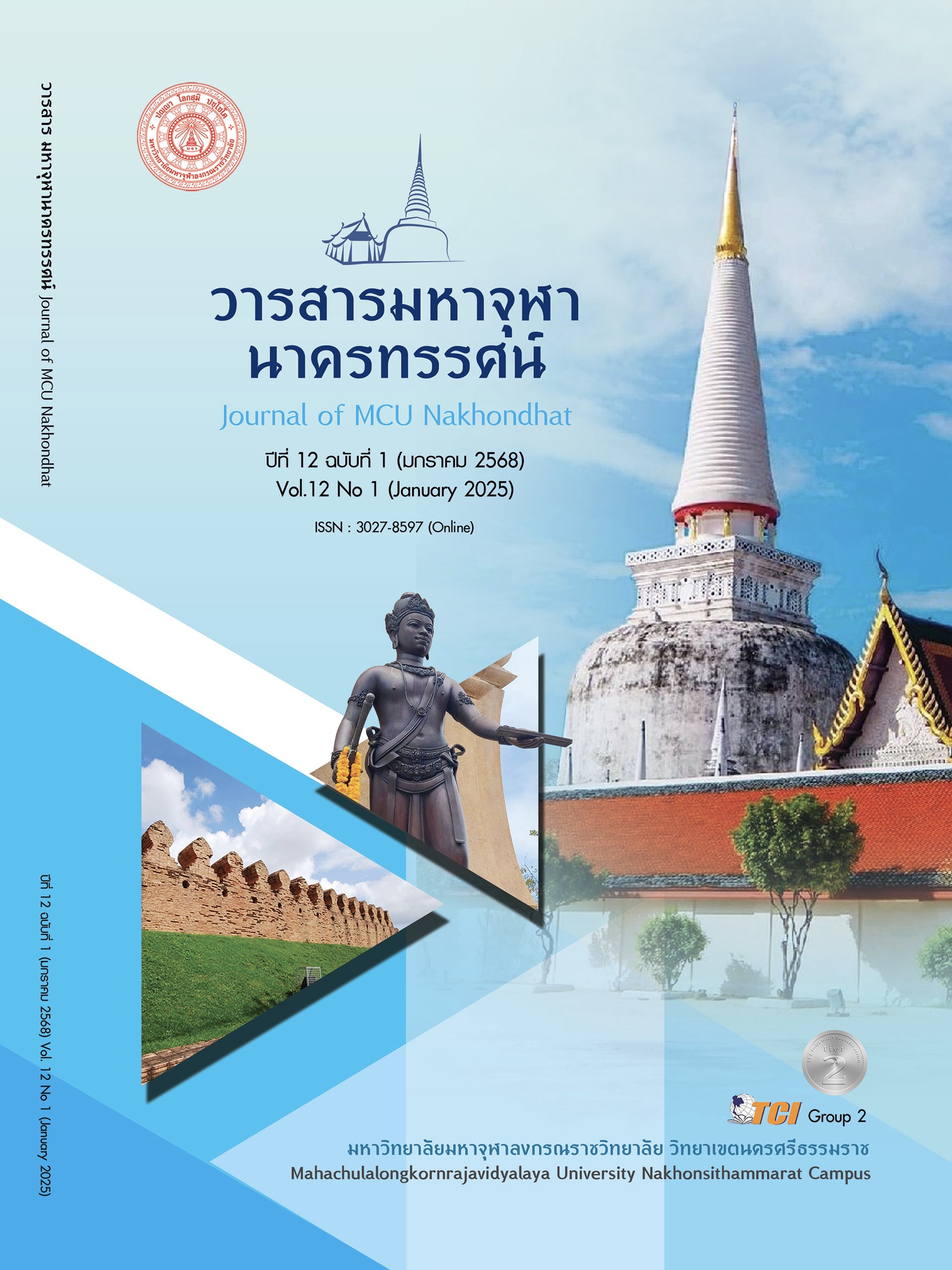PARTICIPATORY COMMUNICATI FOR SUSTAINABLE DEVELOPMENT WITH COMMUNITIES AT ITS CORE
Main Article Content
Abstract
This academic article aims to present participatory communication for sustainable development with community as the core. From the synthesis of research on communication to create participation in driving the community organization council, it was found that for sustainable development, people must participate in the process of thinking, deciding, implementing, and jointly benefiting from that development, with participatory communication as an important tool from the stage of sending information related to development and budget from the sender, which is government officials, community leaders, private sector partners and the public sector, to the people in the area by two-way communication, meaning the sender and receiver can freely exchange information through communication channels including personal media, print media and social media. This article presents a perspective on communication and public participation in the sustainable development process, which are like shadows of each other. Communication is a mechanism to create knowledge, understanding, and the necessity of sustainable development, which is the core of the community’s shared identity, creating bonds and joint social actions for the goal of developing quality of life with the community as the core. Focusing on participatory communication processes at every stage of development will help stimulate and provide opportunities for everyone in the community to participate in thinking, finding problems, and jointly determining solutions that truly meet their needs. It is a guideline for developing the potential of the community to have good management, which will lead to developing quality of life and creating communities that live together sustainably in the future.
Article Details

This work is licensed under a Creative Commons Attribution-NonCommercial-NoDerivatives 4.0 International License.
References
กาญจนา รอดแก้ว. (2564). การศึกษาความคิดเห็นเกี่ยวกับนโยบายการพัฒนาเศรษฐกิจฐานรากเพื่อการพัฒนาอย่างยั่งยืน. วารสารสถาบันพระปกเกล้า, 19(1), 48-66.
โกมาตร จึงเสถียรทรัพย์ และคณะ. (2562). วิถีชุมชน เครื่องมือ 7 ชิ้น ที่ทำให้งานชุมชนง่าย ได้ผลและสนุก. กรุงเทพมหานคร: สำนักพิมพ์แห่งจุฬาลงกรณ์มหาวิทยาลัย.
คณะกรรมาธิการการแก้ปัญหาความยากจนและลดความเหลื่อมล้ำ วุฒิสภา. (2564). รายงานคณะกรรมาธิการการแก้ปัญหาความยากจนและลดความเหลื่อมล้ำ วุฒิสภาเรื่อง การจัดการตำบลเข้มแข็งตามแนวทางยุทธศาสตร์ชาติและแผนการปฏิรูปประเทศ. กรุงเทพมหานคร: สำนักการพิมพ์สำนักงานเลขาธิการวุฒิสภา.
จณัญญา ไผทฉันท์. (2561). หลักการพัฒนาอย่างยั่งยืนกับกรอบความร่วมมือทางเศรษฐกิจอาเซียน: กรณีการ ขนส่งทางอากาศ. วารสารนิติศาสตร์ มหาวิทยาลัยนเรศวร, 11(1), 55-74.
ชลวิทย์ เจียรจิตต์ และคณะ. (2565). นวัตกรรมทางสังคมกับแนวทางการพัฒนาเครือข่ายสัมมาชีพชุมชนอย่างยั่งยืน. วารสาร มจร สังคมศาสตร์ปริทรรศน์, 11(2), 1-14.
เชษฐา ขาวประเสริฐ และคณะ. (2565). รูปแบบการสื่อสารเพื่อจัดการความรู้เพื่อส่งเสริมการท่องเที่ยวเชิงสุขภาพโดยชุมชนบ้านห้วยเหียม อำเภอปากชม จังหวัดเลย. วารสารนิเทศน์ศาสตรธุรกิจบัณฑิตย์, 16(2), 318-341.
สุวิทย์ เมษินทรีย์. (2563). โลกเปลี่ยน คนปรับ: หลุดจากกับดัก ขยับสู่ความยั่งยืน. กรุงเทพมหานคร: กรุงเทพธุรกิจ.
อดิศร คันธรส. (2565). การพัฒนาความเข้มแข็งในการจัดการสุขภาพชุมชนขององค์กรปกครองส่วนท้องถิ่นในจังหวัดเชียงใหม่. วารสารวิชาการวิทยาลัยบริหารศาสตร์, 5(4), 39-54.
อนุศักดิ์ คงมาลัย และคณะ. (2566). การสื่อสารชองเครือข่ายสภาองค์กรชุมชนเพื่อการปฏิรูปประเทศไทยโดยการมีส่วนร่วมของประชาชน. วารสารวิชาการวิทยาลัยบริหารศาสตร์, 6(4), 1-18.
Campbell, S. W. & Kwak, N. (2010). Mobile Communication and Civic Life: Linking Patterns of Use to Civic and Political Engagement. Journal of Communication, 60(3), 536-555.
Cohen, J. & Uphoff, N. (1980). Participation's place in rural development: Seeking clarity through specificity. World Development, 8(3), 213-235.
Dance, F. E. et al. (1976). The Functions of Human Communication: A Theoretical Approach. Michigan: Holt Rinehart and Winston.
Deetz, S. (1999). Participatory democracy as a normative foundation for communication studies. (T. Jacobson & J. Servaes, Ed.) New York: Hampton Press.
Doyon, S. (2012). Seven Keys to Stronger Community. Retrieved March 30, 2024, from https://placemakers.com/2012/10/04/seven-keys-to-stronger-community/
Habermas, J. (1964). The Public Sphere: an Encyclopedia Article. New German Critique, 3(3), 49-55.
McQuail, D. (1983). Mass communication theory: an introduction. London: Sage Publications.
Millikan, M. F. (1967). National Economic Planning: A Conference of the Universities-National Bureau Committee for Economic Research. New York: National Bureau of Economic Research: distributed by Columbia University Press.
Servaes, J. et al. (1996). Participatory Communication for Social Change. London: Sage Publications.
Tufte, T. & Mefalopulos, P. (2009). Participatory Communication. A Practical Guide. Washington, District of Columbia: The World Bank.
United Nation. (2022). MAKE THE SDGS A REALITY. Retrieved February 5, 2024, from https://sdgs.un.org/
White, S. A. et al. (1994). Participatory Communication: Working for Change and Development. New Delhi: Sage Publications.


